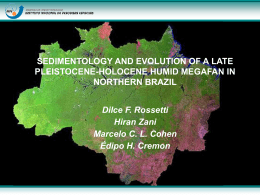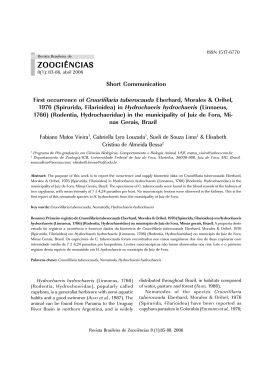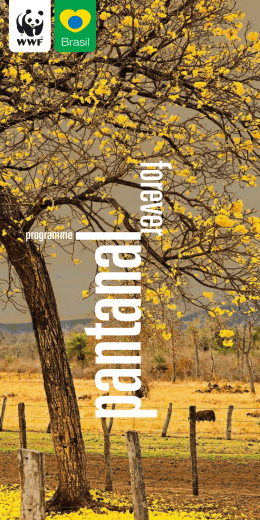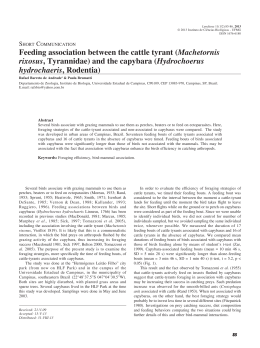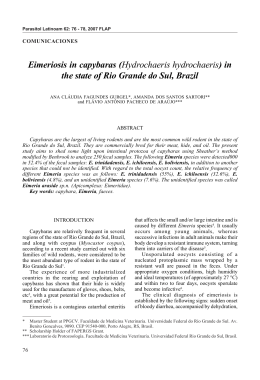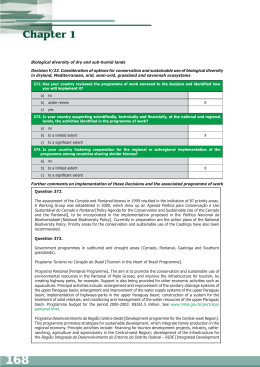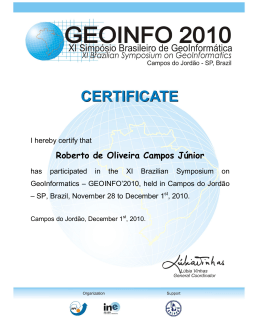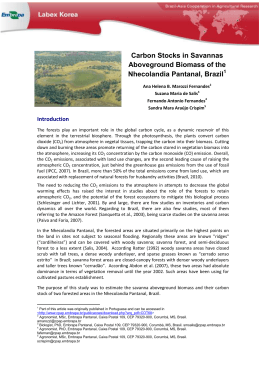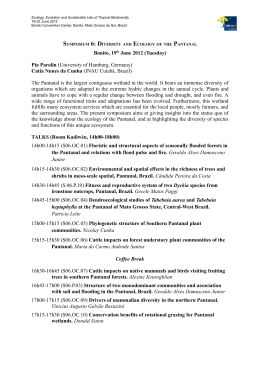REVIST A BRASll,EIRA DE ZOOLOGIA
Revta. bras. Zoo!., S. Paulo 4(2) : 139-149
3.vili.1987
HABITATS, POPULATION DENSITIES, AND SOCIAL
STRUCTURE OF CAPYBARAS (HYDROCHAERlS HYDROCHAERlS,
RODENTIA) lN THE PANTANAL, BRAZIL
Cleber I.R. Alhol
Nelson L. Rondon2
ABSTRACT
( 1) The Pantanal is the central portion ofa sunken flat plain bordering
the upper Paraguay Tiver, with an area of 140,000 km 2. Seasonalfloods begin
in January and end in ApTiI. From May to October tfl!! Iand dries out and
campos (grassIand formations) and scattered pools appear.
(2) Typical capylxzra habitat in the Pantanal is composed ofthree components: the water, a patch of forest, and a grass field for foraging. Highest
densities of capy lxzras (14 individuais jkm 2) were found during the rainy season when the avaiIable spoce for capylxzras was reduced due to the flooding.
Areas without ponds or creeks presented low densities (from 0.38 to 0.84
capylxzrasjkm 2 ) . Group sizes ranged from 2 to 49 individuais ("X = 9.48).
(3) Reproduction occu"ed year-round and young of differem ages were
seen throughout the year. However, the principal recruitment of young to
the population was observed in JuJy-August. Wlúle the females took tums
in caring for young of different ages, probably the offspring ofmothers who
are sisters in the same social groups, the males competed intensively with
each other for access to breeding females. The males reproductive success
appears to be ümited to the number of breeding females that males have
access to in the social group.
INTRODUCTION
The capybara, liydrochaeris hidrochaeris, ·.is the largest rodent in the
world, with adult individuaIs ranging in weight from 30 to 70 kg. It is a se1
Universidade de Brasília, Departamento de Biologia Animal, Laboratório de
/ .001 0 ·
gia e Eoologia Animal, 70910 Brasília - DF, Brazil.
2
Universidade Federal de Mato Grosso, Departamento de Engenharia Florestal. 7liOOO
Cuiabá - MT , Brasil.
140
Revta bras. Zool.
mi-aquatic herbivore whose range spans much of South America, inhabiting
river basins from Panama southwards to Uruguay and Northern Argentina
(Alho, 1982).
The ecology of the capybara in Venezuela and Colombia was ·studied
by Azcarate (1976); Gil, Perea & Ruiz (1976); Ojasti (1968, 1973, 1978);
Ojasti & Medina-Padilla (1972). Some aspects of their behaviour were studied
by Azcarate (1980); and some applied biology was discussed by Escobar &
Gonzalez-Jimenez (1976), and Gonzalez-Jimenez (1977). The most recent
work was conducted in Venezuela by MacDonald (1981). The only published
paper on capybaras in Brazil was that by Schaller & Crawshaw (1981) on
social organization in a capybara population in the Pantanal. Additional information on capybaras in zoological parks outside South America is provided by Donaldson, Wirtz & Hite (1975) and Zara (1973).
Although capybaras are widely distributed and particularly abundant
in some habitats in Brazil, no comprehensive, year-round investigations have
been carried out under natural conditions on the ecology and behaviour of
natural populations. The species ecology, population structure, behaviour
and habitat preferences were studied in order to develop strategies for its
conservation.
The purpose of the present study is to determine the population sizes
for free-ranging capybaras in their natural habitats in the Pantanal ofWestern
Brazil and to interpret the reproductive strategy within the social system of
the capybara groups.
STUDY AREA
The Pantanal is the central portion of a sunken fIat plain bordering the
upper Paraguay river (Fig. 1). The climate is tropical semi-humid and the vevetation consists of marshes, seasonal flooded grasslands interspersed with
clumps or strips of semi-deciduous forest, and patches of cerrado, and a
denser kind of cerrado or cerradão. The Pantanal is located near the geographic center of South America. The Cuiabá River is a part of the Pantanal
depression and includes an area of about 140,000 km2 in Brazil, between the
latitudes 19 0 and 220 30'S, being 450 km long and 280 km wide at the latitude of Corumbá. The Pantanal extends only slightly into Bolivia and Paraguay. The surface slope patterns create three major provinces: the upper
Pantanal, the middle Pantanal and the lower Pantanal, each with a typical
vegetation formation. ln the upper Pantanal, flooding is localized and the
water levei rises 30 to 40 cm and lasts for 2 to 3 months a year. The dominant vegetation types are campo (a grassland fonnation), cerrado (a savanna
woodland) and forest. The middle Pantanal is a transítion zone with deeper
flooding, wich lasts for 3 to 4 months. The lower Pantanal is composed of
seasonally flooded campos cut by forests , where the area is. extremêly fIat.
Vol. 4(2), 1987
141
MATO
GR05S0
,.0
r
;
"'-...
BOLlVIA
'
.. .. .
......
PARAGUA'f'
~
________________
~
____
~
__________
-4~
__________
w
58'
8(/
---
~
I.. II II
-
- -
!- ! ~
---. __ .
Pantanal
140.000 km'
~24°S
National
BoWldary
___________ State
Boundory
Fig. 1 - The Pantanal of western Brazil where capybaras are stiU abundant. This biome
is one oí" the Neotropics' largest swamplant wildemess.
142
Revta bras. Zool.
The study areas of Poconé and Nhecolândia are both located in the lower
.
province of the Pantanal.
Floods begin in January and end in April. From May to October the
land dries out and the campos and scattered pools appear. Maximum rainfall
occurs in December and January with an annual average precipitation of
1300mm. Floods begin in the upper Pantanal and extend to the lower. Since the land is flat, large areas rapidly become inundated. The peculiar hydrography of the Nhecolândia Pantanal creates several small round lakes , locally called bafas. Seasonally flooded grasslands cover about 20% of the area.
The mean aímual temperature is 25 0 C and ranges from 27,4°C in December to 21.4 0 in July. During the cool period from June to August temperatures may occasionally drop close to OOC. Annual extremes usually range
from around 50 to 41 oCo
The vegetation of the ecosystem is called the ''Pantanal Complex".
The open formations are the flood-plain grasslands, corresponding to treeless savannas, which during the long dry season, in many higher areas, develop
into bush savannas and woodland.
Our research was conducted on private land, mainly cattle ranches ,
close to the research station of IBDF-DN located at kilometer 115 on the
Transpantaneira Road that crosses the Pantanal from Poconé to Porto Jofre ,
in the State of Mato Grosso. Some field observations were also made at the
Fazenda Nhumirirn in the Nhecolândia Pantanal, about 150 km SE of Corumbá, in the State of Mato Grosso do Sul.
The vegetation of the two study areas differed greatly . ln Poconé the
patches of forest have a high, closed canopy (15-20 m) and the trees are
mostly drought-deciduous. ln Nhecolândia, ce"ado and ce"adiJes (a denser cerrado) replace the taner forest. The area most closely resembles the
ce"ado of central Brazil. The water used by capybaras in Poconé is in forrn
of creeks named corixos and small ponds, whereas in Nhecolândia the capybaras use medium~ezed ponds varying from 5 to 25 ha in area, and
surrounded by seasonally flooded grassland .
Habitats of Poconé
The Pantanal of Poconé comprises 13% of the total Pantanal area and
has a medium inundation regime with the water depth varying from a few
centirneters up to 6 meters and with flooding lasting from 4 to 8 months per
year. The corixos cut the seasonally flooded grasslands. Gallery forest, or
cordilheiras, grow on higher elevations that are rarely flooded. This vegetation is about í 5 m high and has a closed canopy: f::Ierbaceous vegetation
is lacking. Some cordilheiras, known as campos de cambarazais, are semi-open and dominated by the species Vochysia divergens. The type of
woodland containsherbaceous vegetation .
143
Voi. 4(2),1987
The grassland~ are natural pastures cut by the cordilheiras and corixos. ln some areas there are relatively dense populations of spiny shrubs
(Mimosa sp). about SOcm high. ln some of the campos the grasses cover
about 90% of the ground. PaspaJum nota tum gives these areas their bright
green coloro This habitat ·is occupied in large part by grasses, herbs and
shrubs including the following species which our· observations showed to
serve as food for the capybaras: Pontederia lanceo/ata, Echinodorus tenel/us,
Cyperus .sesquiflorus, E1eocharis fistulosa, Aesehnomene sensitiva, Teramus
sp. and Vigna sp. Usually these campos are overgrazed by.wild herbivores
and cattle which makes plant identification dimcult. Close to the water the
campo gives way to adense shrub community, principally of lpomoea fistulosa and Discolobium pu/chel/um. ln this flooded area the commom species are Aeschynomene sp. which the capybaras use as a food, and Eichhornia crassipes, as well as other floating plants. ln dry areas close to the water,
Paspalum notatum, Salvinia auricu/ata, and other species provide ground
cover.
Habitats of Nhecolândia
The Pantanal of Nhecolândia comprises 17% of the total Pantanal area
and is also an area of medium inundation. Water depth here varies from a
·few centimeters to 4 m and the flood season may range from 4 to 6 months.
The forest patches, or captJes de mata are cerrado or cerradtlo with guatam-
bu (Aspidosperma o/ivacea), aroeira (Astronium urundeuva), angelim (Andira cuyabensis), paratudo (Tabebuia caraiba), piúva (Tabebuia impetiginosa), acuri (Schee/ea pha/erata) piúva cascudo (Tabebuia ochracea), and other
trees. Some capiJes are dominated by the palm carandá (Copernicia australis) and bocaiúva (Acrocomia sclerocarpa). The natural pastures are composed essentially ofAxonopus purpusii, Mesosetum loliiforme and Panicum ·
/axum, all eaten by capybaras. Pott (1982) pointed out that legumes, such
as Desmodium barbatum and fura-bucho (Paspalum sp.) are also abundant
and other plants, such as Helicteres sacarolha, Ocotea sp. and Tocoyena formosa are on1y .occasional components of the diet of capybaras. The natural
pastures, where grasses are dominant, have been invaded by low trees and
shrubs such as Bromelia balansea, Byrsonima intermedia and Vernonia seabra. Other species that possibly serve as food for the capybaras are Andropogon bicornis, A. hypogynus, A. selloanus, Axonopus leptotachyus, . Elionuros candidus, Gymnopogon sp., Ichnanthus procurrens, Panicum sp., Paspalum plicatu/um, Paspalum sp., Raimarochloa brasiliensis, Setaria geniculata and Trachypogon sp. (Pott, 1982).
The ponds, or baiàs, are surrounded by Grarninae and Cyperaceae, but
when they become dry they are invaded by shrubs.
144
Revta bras. ZooI.
METHODS
The field work was conducted from January 1983 to January 1984.
We censused capybara populations in both Poconé and Nhecolândia. ln Poconé we counted group sizes twice a day, 10 days per month, over the course
of 1 year within an area of 250km 2 • Thus, during 10 consecutive days of
each month, from 07.00 to 18.00 hours, census studies were exhaustively
carried out spanning the two different seasons. Each day the census routes
were covered, one in the morning, the other in the afternoon until dusk, aiternating the order morning-afternoon to obtain a balanced coverage of capybara groups observed in different activities. Two to four searched the census route by car, recording the identity of the social group, position , activity , number of animais in the group, sexes, size classes , and location of each
animal seen. ln the Pantanal, capybaras are accustomed to the presence of
cars and allow the presence of observers in a jeep rather than someone walking. Since groups frequently encountered in the sarne general area, we
were able to obtain data on the average size of each of the groups in the
census area . We conducted censuses in the sarne manner in Nhecolândia during 3 months of the dry season (July, August and September) in an area
of 120km 2 .
Adult males were distinguished from adult females by the presence
of a protuberance , the supranasal gland, on the snout (ReweIl1950 ; MacDonald , Krantz & Aplin 1984). Sub-adults and young were not separated by
sex o We distinguished only three age classes: young, sub-adults and adults.
Young have a slightly brighter color and texture to the pelage. Weights varied
between approximately 1.5 and 10 kg. Sub·adults were animals between 6
and 10 months of age . They were distinguished on the basis of size and lack
of either adult or youg characteristics . Animals of 14 months or older are
c1early adults and possess adult secondary sexual characteristics. Misclassifi·
cation by age occurred most frequently with the few individuals that were
transitional between any two of the above age classes. We were able to cate·
gorize individuals by age and jor sex in 80% of the observations.
We present estimates of both crude density and ecological density . The
estimates of crude density represent the number of animals occurring over
the entire area censused (250 km 2 in Poconé and 120 km 2 in Nhecolândia) .
The estimates of ecological density represent the number of animals occurring
only in habitats most used by capybaras ; as a consequence these figures are
always higher than those for crude density although the figures changed from
month to month. We calculated density by summing the average number of
individuals per group for ali groups present , then dividing by the area . The
area used in the denominator was the total area of the census for crude den·
sity and the total area of available capybara habitat for ecological density,
that is , the habitat offering water , a patch of forest and pasture which cons·
tituted the most used area by capybaras. Areas not considered as suitable
capybara habitat included large lakes , elevated plateaus, extensive stands of
VOJ.
4~~), l~lS
I
forest, and heavily manipulated ranch and farm Iands. Densities were converted to biomass by multipIying the number of individuaIs by the average
weight of a capybara (30 kg) (Eisenberg, O'Connell & August, 1979).
One area, the Capão do Júlio, was more intensiveIy studied in order to
collect data on social organization. All observations were collected on one
group of 14 capybaras ofknown sex and age. AnimaIs were observéd between
06.00 and 18.00 (or until dark) for 10 days each month throughout the course of I year. Observations were made with binoculars from behind a blindo
Every 10 minutes, the behaviour of all animals visibIe (t;;;; 14) was noted. This
group was observed in an area with all three of the habitat components utilized by capybaras (forest, campo and water).
RESULTS AND DISCUSSION
Densities of Capybaras in the Pantanal
We observed the highest ecoIogical densities of capybaras during the
rainy season, between January and April (TabIe 1). The higher densities
observed during the rainy season are due to the reduced availabIe space for
the capybaras due to tj1e flooding oflarge areas of campos.
During the period of the year groups were more concentrated in higher
are as (capões and cordilheiras) which were easier to Iocate during the flood
season. The animaIs are 'more aggregated within the availabIe space. The
flooding affects crude densities because animaIs apparently move into the
study area escaping from nearby areas now inundated. Th,e Iowest densities
of capybaras were observed in acurizal habitat of the Pantanal of Poconé.
Acurizal is dorninated by the palm acuri (Scheelea phalerata) and has no
Table 1 - Density, group size, and biomass oC capybaras at Poconé and Nhecolândia in
the Brazilian Pantanal, Data Crom Poconé and Nhecolândia are combined (Nhecolândia
was censused only during the dry season) as there were no diCCerences in densities and
group sizes between the two sites.
EcologiMonths cal
density
(km 2 )
]-F
M-A
M-]
]-A
S-O
N-D
14.61
14.82
5.43
7.94
7.62
6.48
Number
oC
groups
seen
and
counted
35
89
92
79
64
61
Mean
group Standard
size
error
8.18
6.34
9.26
13.18
11.83
9.97
2.48
1.37
0.37
0.35
0.34
0.59
Mean
Range
max.
min_
34.0
32.0
22.0
14.6
13.3
233
0.2
0.3
0.4
0.4
0.4
1.3
Estinnlc
Estimated
ted
Biomass
(kg/km2)
crude
density
(km 2 ) Ecolo- Crude
gical
0.44
0.84
0.39
0.45
0.3.8
0.64
438.3
444 .6
162.9
?38.2
228.6
194.4
13.2
25 .2
11.7
13.5
11.4
19.2
146
Revta bras. Zoo1.
ponds or streams, and no grazing areas. Capybara ecological densities in QCUrizal ranged from 0.34 to 1.39 capybaras/km2; tlús compared to ecological
densities in more heavily used habitats of 5.43 to 14.82 capybaras/km2.
Eisenberg, O'Connell & August (1979) calculated an ecological density of 10
capybaras/km 2 in the lIanos of Venezuela.
The most heavily used areas were those that had three habitat components: forest (cordilheiras or capão), a grazing area (campo), and the proximity of water (baías, corixos). Capybaras use the campos for foraging
and most other behavioural activities as well. The forest fumishes sheIter
from the mid-day heat and a resting pIace at night. The presence of water
provides aquatic vegetation, which is an important forage, especially during
the rainy season.
Our observations show that the use of these habitats varies seasonally.
Duriog the dry season, capybaras spend the night in the forest, between 20.00
and 06.00 or 07.00. ln the earIy morning they leave the forest and graze in
the campos until 11.00. They retum to the forest ai 11.00 but at 14.00 they
emerge and spend the mid-aftemoon (14.00 to 15.00) in the water. From
15.00 to 20.00, they spend most of their time grazing, occasionally returning to the water. Duriog the rainy season, the capybaras aIso spend the
night (20.00 to 08.00) in the forest, but in the moming usually emerge and
go directly to the water instead of grazing in the campos. The rest of the day
is spent inthe water and in the grazing areas which have not been flooded,
with the exception of a brief period between 11.00 and 15.00, when the animais return to the forest. We observed a substantial increase in the use of
aquatic vegetation and forest vegetation in the diet at that time, since little
grazing area remains.
Reprotuction occurred year-round, since young of all ages were seen
throughtout the year. However, we observed a peak period of births from
July to October. The period of greatest recruitment to the adult population
occurs between May and October, when the greatest incre ase in absoIute
numbers of animais is observed. The greatest increase in the population
occurs with the recruitment of young animais which .incre ases group sizes
(30% of young).
Social Structure and Use of Space
We collected 2881 observations of the target capybara group during the
year of study. Capybaras have a cónspicuous social structure that reflects
group sizes. As soon as the s.ub-adults begin to attain sexual maturity, some
are excluded from the social groups by the dominant males. The group size
increase from the beginning (rainy season) to the middle of the year (dry
season). Capybara groups exhibited annual variations in size, smaller during
January~April (x = 7.26; 0.55 SE; n = 860 and larger during May-December x = 11.83; 0.94 SE; n = 964). This difference was due to recruitment
(lf youne into population. The largest capybara group observed was seen
Vol. 4(2), 1987
147
during J uly-August and contained 49 members almost 50% of them young
animals. Groups of 5-10 were relatively common during ali months, comprising about 80% of all the groups. Usually there was one dorninant adult
male; one or two adult submissive males; four or five adults females and the
rest sub-adults or young. During the floods the groups subdivided and are
largely confined to the forest patches (cordilheiras and cap<5es) whlle in the
dry season more animaIs are observed feeding on the pasture of the campos.
At this time of the year there are more young in the group. Due to the social structure, joining and splitting of groups and mdividuaIs are common.
The male: female sex ratio for 89 young captured in the field or bom
in our experimental station was 1 : 1. However, the sex ratio of the adult population in the field is 1: 3 (males: females). We. found the following in ninety-five social groups observed: mean number of males = 1.37, N = 130,
0 .74 SD; mean number of females = 4,00; N = 386 , 2.90 SD ; mean number of sub-adults = 1.34, N = 2.39 SD, and mean number ofyoung = 3 .07 ,
N = 292,3.95 SD.
About 8% of the capybaras W8re solitary or satellite individuaIs . We
found solitary sub-adults injured by other individuais and some were ill and
walking with difficulty. One individual captured in that condition showed a
very high concentration of Tryparwsoma sp. in the flood . It is more
common to find solitary sub-adult males or satellite full adult males than
Ione females. Male groups of two or three members occasional1y were seen,
but male groups with more than four members were uncommon.
As exarnination of 948 field observations of aggressive interactions in
the Capão do Júlio group showed adult male x male aggression accounted for
37.85 % adult male x female 24.23%; adult female x adult femaIe 12.25%
and adult (both sexes) x sub-adult 2930%. Aggression between males often
invoIves high leveis of combat. Sub-adults of either sex were always subordinate to adults. The dorninant male of the group initiated an attack , 15% of
the observed attacks were started by dominant females.
At times aggressive interactions spread through the group and , when
this happened, many of the subordinate males and females were excIudea
for 1-3 h as a result of attacks. Encounters between different groups, in areas
where the home ranges overlapped, were characterized by strong fighting
between dorninant males .
The some range of a group comprises the foraging area, a patch of forest and water. Groups in a preferred habitat occupy a core area of about
1 km 2, and may share an additional2 kJn2 with other groups .
Several studies on mammalian social structures have revealed that the
males' reproductive success is reIated to the fighting ability of the individual
in the group. The male's reproductive sucess is usually lirnited to the number of breeding females that males have access to in the social group. The
result of the intense aggressive interactions between capybara males is a social structure that favors greater number of females and young or sub-adult
148
Revta bras. Zool.
individuais. The number of agonistic interactions per individual increases
with group size, from 7.8 for a group of 5, to 18.4 for a group of 10, and
18.6 for a group of 15 in captivity (Parra, Escobar & Gonzales-J imenez 1978 ;
Ojasti & Burgos 1985). Aggression increases and reproduction and survival
decrease when the group size is larger.
ln the Pantanal, the ability of capybaras to adjust to their environrnent,
physical, biological and social, may be indicated by their response to different ecologícal pressures.
ACKNOWLEDGMENTS
This research was supported by the mDF (Departamento de Parques
Nacionais e Reservas Equivalentes) in the area of Poconé and by EMBRAPA
(Empresa Brasileira de Pesquisa Agropecuária) in the area of Nhecolândia.
The research would not have been possible without the help of many field
assistants. We would like to thank Tereza Cristina Magro, Júlio Dalponte,
Pedro Nonato Conceição, Zilca Maria Campos, Humberto Gonçalves, Estelito,
Tito, and many others for their help. Francisco Breyer assisted us in arranging
for local research facilities. Thomas E. Lacher, and Anthony B. Rylands
reviewed the manuscript.
REFERENCES
Alho, C.J.R. (1982). Brazilian Rodents: Their Habitats and Habitats. Pp. 143-166
Mammalian Biology in South America (Ed. by M.A. Mares and H.H . Genoways).
The Pymatuning Symposia in Ecology, Special Publication Series, Pymatuning
Laboratory ofEcology, University of Pittsburgh, Pittsburgh, Vo16 : XII + I - 539.
Azcarate, T. (1976). Algunos datos sobre el comportamiento social em una manada de
chiguires (Hydrochaerus hydrochaeris). Pp. 13-15, Abstract: II Seminário sobre
chiguires (H.h.) y las babas (C.c.). Programas y resumenes, 116 pp. Consejo Nacional de Investigaciones Científicas y Tecnologicas, Caracas .
Ascarate T. (1980). Sociobiologia y manejo deI capibara (JIidrochaerus hydrochaeris).
Donana Acta Vertebrados 7 (6): 1-228.
Donaldson, S.L., Wirtz, T.B. & Hite, A.E . (1975) . The social behaviour of capybaras .
(Hydrocluzerus hydrocluzeris) at Evansville Zoo. International Zoo Yearbook 15 :
01-206 .
Eisenberg, J.F. , O'Connell, M.A. & August, P.V. (1976) . Density productivity , and distribution of mammals in Mo Venezuelan habitats. Pp. 187-207 Vertebrate Eco·
logy in the Northern Neotropics (Ed. by J .F. Eisenberg). The National Zoological
Park, Smithsonian Institution Washington, D.C., U.S.A.
Escobar, A. & Gonzalez-Ji{llenez , E. (1975). Estudio de la competencia alimenticia de los
herbivoros mayores der llano inundable con referencia especial ai chiguirre. Agro·
nomia Tropical, 26 : 215-227.
Gil, A., Perea J. & Ruiz, S. (1976). Habitos territoriales y comportamiento social dei
149
Vol. 4(2), 1987
Gil , A., Perea J . & Ruiz , S. (1976) . Habitos tcrritoriales y comportamicnto social dei
"chiguirre " (H .h .h .) Pp. 11-12 II SemiTlilrio sobre chiguirres (H.h.) y las babas
(C. c.) . Consejo Nacional de Invcstigacioncs Científicas y Tecnologicas, Caracas,
116 pp.
Gonzales-Jimenez , E. (1977) . The capybara - an indigenous source of meat in Tropical
America. World Animal Review (FAO) , 21 : 24-30 .
MacDonald, D.W. (1981) . Dwindling rcsourccs and the social behaviour of capybaras
(Hidrochaerus hydrochaeris) (Mammalia) . Journal of Zoology (London) , 194 :
371 -391.
MacDonald , D.W., Krantz , K. & Aplin, R.T . (1984) . Behavioural anatomical and chemical aspects of scent marking arnongst capybaras (Hydrochaerus hydrochaeris) (Rodentia: caviomorpha) . JourTlilI of Zoology (London) 202 : 341-360.
Ojasti, 1. (1968). Notes on the mating behaviour of the capybara. JourTlilI of Mammalogy, 49 : 534-535 .
Ojasti , J. (973) . Estudio biologico dei chiguirre capybara. Fondo Nacional de Investigaciones Agropecuarias , Editorial Sucre, Caracas, 275 pp .
Ojasti, J. (1978) . The relation between population and production of capybara (Hydrochaerus hydrochaerisl . Unpubl. Ph.D . dissert., University of Georgia, Athens,
U.S.A., xi + 204 pp .
Ojasti , 1. & Medina-Padii,la, G . (1972) . The management of capybara in Venezuela, Transactiom North American Wildlífe and Natural Resources Conference, 37 :268-277.
Ojasti, J . & Burgos, LJ . (985 ). Density regulation in population of capybaras. Acta
Zoologica Fennica 173 : 81-83 .
Parra, R., Escobar, A. & Gonzales-Jimenez, E. (1978). El chiguire, su potencial biológico y su cría en confrnarniento. Informe Anual de Instituto de Procucion Animal
(Maracay).' 83-93 .
POU, A. (1982). Pastagens das sub-regiões dos Paiaguás e da Nhecolândia do Pantanal
matogrossense. EMBRAPA . Circular Técnica ri! 10, 49 pp.
Rewell, R.E. (1950) . Hypertrophy of sebaceous glands on the snout as a secondary male sexual character in the capybara (Hidrochaerus hidrochaeris) . Proceedings of
the Zoological Society of London, 119 : 817-819.
Schaller, G.B. & Crawshaw, Jr. P.G. (1981). Social orgaIiization in a capybara population. S/Jugetierkundliche Mitteilungen 29 (1).' 3-16.
Zara, 1.L. (1973). Breeding and husbandry of the capybara (Hidrocluzerus hydroc1llleris)
at Evansville Zoo. InternatioTlilI Zoo Yetlrbook, 13 : 137-139.
°
Download
